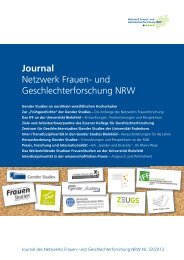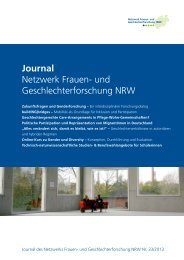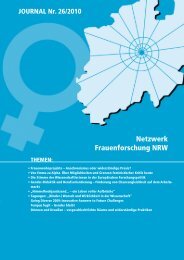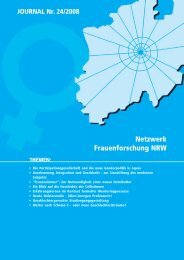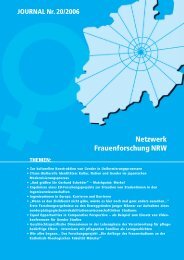Download (2 MB) - Netzwerk Frauen- und Geschlechterforschung ...
Download (2 MB) - Netzwerk Frauen- und Geschlechterforschung ...
Download (2 MB) - Netzwerk Frauen- und Geschlechterforschung ...
Erfolgreiche ePaper selbst erstellen
Machen Sie aus Ihren PDF Publikationen ein blätterbares Flipbook mit unserer einzigartigen Google optimierten e-Paper Software.
Beiträge<br />
20 <strong>Netzwerk</strong>-Journal Nr. 12/2001<br />
is in strong need of further inquiry.<br />
Comparative studies regarding the<br />
professional situation of women in<br />
Europe do exist but do not focus on<br />
vertical segregation in universities.<br />
The most important field of comparative<br />
studies dealing with women’s labour-market<br />
participation in Europe<br />
is the analysis of the gendered aspects<br />
of welfare systems. These studies<br />
show that countries vary in their<br />
social, family and labour market policies<br />
and that they therefore differ in<br />
the extent to which they promote or<br />
restrain women’s employment<br />
(Schunter-Kleemann 1992, Garcia-<br />
Ramon/Monk 1996, Lewis 1993,<br />
Sainsbury 1994). Thus, various studies<br />
have contributed to an explanation<br />
of the differences in women’s integration<br />
into the job market, but they<br />
do not account for the vertical segregation<br />
in work-places. Another strand<br />
of comparative research is studies<br />
dealing with the issue of gender and<br />
are focussing on issues of vertical segregation<br />
in the European Union.<br />
However, they deal with the issue on a<br />
general labour market level and give a<br />
first general survey of the extent to<br />
which women are <strong>und</strong>er-represented<br />
in the labour markets and try to determine<br />
possible causes of this phenomenon<br />
(Plantenga/Tijdens 1995, European<br />
Commission 1997). Above all,<br />
these investigations testify to a<br />
strong demand for in-depth research<br />
in this area. Comparative studies on<br />
women in higher education are few<br />
but provide a basis for further investigation.<br />
Thus some studies focus on<br />
cultural and societal explanations for<br />
the gender gap in higher education<br />
(Lie 1994) or approach the problem<br />
analysing and comparing different<br />
concepts of affirmative action and<br />
their impact on academic careers (Färber/Henninger<br />
1995, Grimm 1995).<br />
Recently, the problem of the <strong>und</strong>errepresentation<br />
of women in the European<br />
universities has been brought<br />
into focus: the need to encourage the<br />
participation of women in the European<br />
science system is increasingly<br />
stressed (Rose 1999). First statistical<br />
overviews on the situation of women<br />
in the academic world show that the<br />
<strong>und</strong>er-representation of women at the<br />
highest levels of the academic hierar-<br />
chy is a feature of all the European<br />
higher education systems, but point<br />
out that differences exist between<br />
Northern and Southern European<br />
countries regarding the number of<br />
women in positions of authority (Osborn<br />
1999). All recent studies highlight<br />
the need for a systematic European<br />
investigation of gender-specific<br />
data and reflect the need for comparative<br />
in-depth analysis in order to encourage<br />
the equal participation of women.<br />
In order to perform such a comparative<br />
in-depth analysis, research in<br />
the field of systems of higher education<br />
is relevant to the research. The importance<br />
of the aspect of the internationalisation<br />
of the European systems<br />
of higher education is reflected by a<br />
growing number of comparative European<br />
studies (European Commission<br />
1991, European Commission 1993,<br />
Gellert 1993, Higher education in Europe<br />
1991) which deal with the various<br />
structural models of higher education<br />
(Teichler 1990), but which also thematize<br />
aspects such as market orientation<br />
and competitiveness as significant<br />
subjects within the current reform<br />
debates (Neave/Van Vught 1993,<br />
Frackmann/Maassen 1992). Also,<br />
higher education policy becomes<br />
increasingly the object of comparative<br />
policy analysis (Goedegebuure 1993).<br />
At the same time studies of the administrative<br />
structures of the various<br />
systems (Klostermann 1997) and the<br />
elaboration of statistical indicators<br />
for the comparative analysis of systems<br />
of higher education (Kazemzadeh<br />
et al 1994) provide a basis for a<br />
close examination of the effect of<br />
structural factors on the professional<br />
chances of academics in Europe.<br />
However they do not address genderspecific<br />
aspects (List 1994).<br />
In contrast to this neglection of<br />
gender-specific aspects of higher<br />
education structures, within organisational<br />
theory, there is a growing<br />
number of studies that focus on gender<br />
and organisations and that may<br />
serve as a basis for the analysis of<br />
gender-specific structures in the university<br />
(Acker 1990, Cockburn 1991,<br />
Acker 1994, Martin 1994, Alvesson/<br />
Due Billing 1997). The examination of<br />
organisational culture (Schein 1985,



